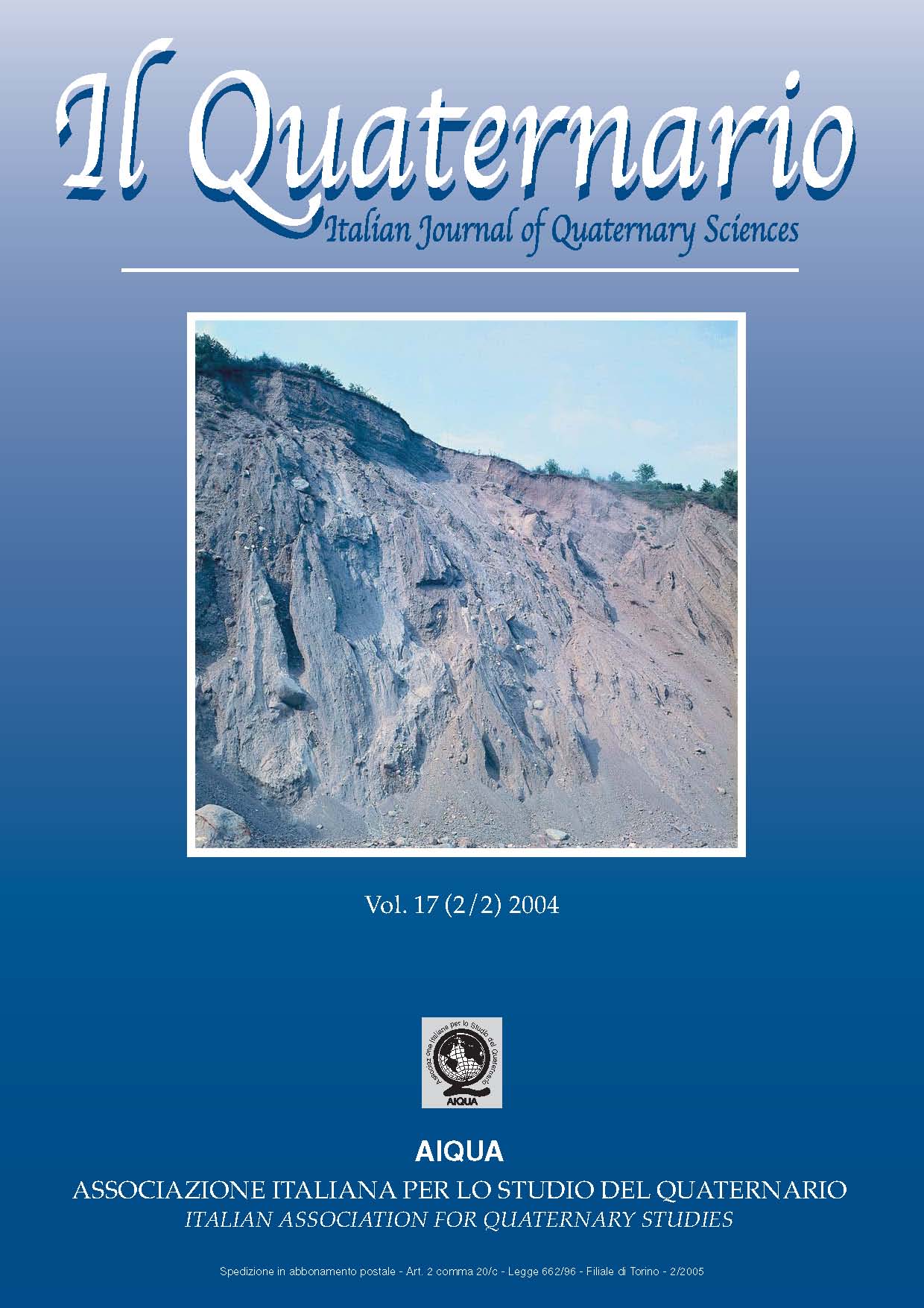CARATTERIZZAZIONE IDROCHIMICA DI UN ACQUIFERO SUPERFICIALE: IL CASO DELLA CIRCOLAZIONE IDRICA NEI CORPI DI FRANA NELLA DORSALE CARBONATICA DI M. PIETRALATA – M. PAGANUCCIO (APPENNINO MARCHIGIANO)
Main Article Content
Abstract
Capaccioni B., Nesci O., Sacchi E. M., Savelli D. & Troiani F., The hydrochemical feature of surficial groundwaters: the groundwaters from landslide deposits of the carbonatic ride of Mts. Pietralata-Paganuccio (Marche Appennines. (IT ISSN 0394-3356, 2004).
Geological-geomorphological and hydrochemical studies have been carried out throughout the anticline ridge of Pietralata-Paganuccio Mts. (northern Umbria-Marche Apennines, Central Italy) in order to find a possible correlation between the large landslides almost affecting the entire mountain flanks and spring-water characteristics. The study area embraces the northernmost sector of a much longer calcareous anticline ridge extending all along the Marche Region. The Furlo Gorge, a narrow transverse canyon deeply cut by the Candigliano River (Metauro River basin), breaches the anticline ridge separating the two mountains from each other. This sector of the ridge, although rather simple as for its morphostructure, is indeed one of the most important examples of such landforms so characteristic of the Umbria-Marche Apennines. Pietralata and Paganuccio Mts. consist of the mostly calcareous and marly-calcareous MesoCenozoic units of the Umbria-Marche Succession. The Jurassic-Cretaceous terrains, ranging from the Calcare Massiccio Fm. and the Scaglia Bianca Fm., crop out in the Furlo Gorge area only, deeply cut in its turn at the core of the anticline. The flanks and the crest of the anticline ridge, on the contrary, are made up of Createceous-Oligocene terrains, namely Scaglia Rossa-Scaglia Cinerea and Bisciaro Fms. Pietralata and Paganuccio Mts. are an explicatory example of an exhumed anticline, where the geological structure is distinctly replicated by the relief topography. Indeed, the ridge morphology almost perfectly displays both the rounded geometry of the anticline and its northwestern and southeastern plunge-out areas. Furthermore, characteristic flat top-surfaces markedly reflect the sub-horizontal/gently-dipping bedding of the hinge zone, while the mountain sides slope at angles approximating the downslope-dipping layering values. Although the peculiar morphostructural arrangement of the ridge has been shaped by different processes, the role of large, deep-seated mass movements is once more today among the most effective ones. Landslides, affecting both sides of the ridge for the most part, find their key predisposing factors in the dip-slope layering attitude on the two sides of the anticline ridge, as well as in the occurrence of weak marly horizons (e.g. Marne a Fucoidi Fm., marly members of Scaglia Rossa Fm., etc.),embedded among calcareous units in different stratigraphic positions. The occurrence of an intense local rock-fracturing is an effective additional predisposing factor. As a result, the most part of the anticline ridge flanks have been extensively denudated by more or less shallow landsliding, able to highlight both lithologic contrasts of the Jurassic-Miocene “multilayer” and structural features, such as fault-zones and bended bedding surfaces. The gravitational sagging and collapse of the anticline flanks encompass several, different field evidence. As a rule, the landslide head areas display tension cracks and more or less distinct trenches, scarps and counterslopes; the slid mass becoming more and more disrupted and chaotic downslope, where an over-100m thickness is often reached and stressed by deep gully dissection of the landslide mass. Indeed, the substantial permeability acquired by progressive fracturing of the sliding rock bodies allows for a great number of frequently perennial aquifers and springs to occur within the slid-bodies and/or at the toe of the major landslides. On the contrary, in some places, the landslide materials have probably blanketed some springs related to relatively deep bedrock aquifers. Hydrochemical data show that the characteristics of the majority of the analysed waters set in the field of Ca2+ -HCO3 - compositions, with two different trends, namely “A”, trending towards Na+ - Cl- compositions, and “B”, trending towards Ca2+ - SO4 2- compositions. A possible reason of these two trends is the mixing of superficial water circulating inside the landslide masses with waters flowing out from deeper bedrock-aquifers. Water samples from the Pietralata Mt. area, according to the most part of waters from carbonatic rocks of the Marche Region, display contents in Ca2+, Mg2+ and HCO3
- which are mostly due to magnesian-calcite solution or, alternatively, to a mixing of calcite and dolomite (this latter, especially for waters from relatively deep aquifers). As regards water saturation in calcite at different PCO2 conditions, the analysed samples display a range of values approximating those typical for soils (0.15 bar). Being such values much higher than those already reported for carbonate aquifers of Nerone Mt. (0.0003 – 0.003 bar), a near-surface water circulation can be alleged. In this respect, a similar assumption can be drawn from both the relatively low discharges of the studied springs, and from the recurring traces of NO3
- concentration. As regards this latter, in particular, its relatively high concentration in both 1984 and 2004 samplings is likely to be related to both biologic activity and humification (nitrification) on the surface of the slid-masses, although a less important amount of NO3 - from fertilizers cannot be ruled out. Moreover, a low Ca2+ - SO42- composition of the samples at issue can be related to the mixing of relatively deep waters from bedrock aquifers whose springs are blanketed by thick landslide accumulations. Finally, the observed trend “A”, towards Na+ - Cl- compositions, can be ascribed to cyclic salts coming from near marine areas.
Article Details
Section

This work is licensed under a Creative Commons Attribution-NonCommercial-NoDerivatives 4.0 International License.
The Author grants usage rights to others using an open license (Creative Commons or equivalent) allowing for immediate free access to the work and permitting any user to read, download, copy, distribute, print, search, or link to the full texts of articles, crawl them for indexing, pass them as data to software, or use them for any other lawful purpose.

